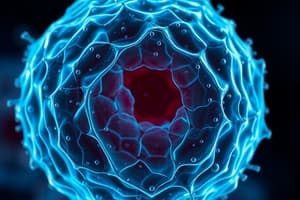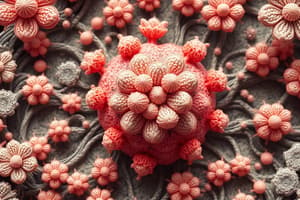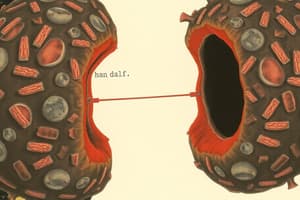Podcast
Questions and Answers
What primarily causes atrophy in cells?
What primarily causes atrophy in cells?
- Increased protein synthesis
- Increased metabolic activity
- Enhanced cell division
- Decreased protein synthesis (correct)
Which type of atrophy occurs due to loss of nerve stimulation?
Which type of atrophy occurs due to loss of nerve stimulation?
- Atrophy of disuse
- Ischemia atrophy
- Physiological atrophy
- Denervation atrophy (correct)
What is a common example of physiological atrophy?
What is a common example of physiological atrophy?
- Ischemic changes in tissue
- Atrophy of a limb after immobilization
- Thymus gland in a fetus (correct)
- Atrophy due to inadequate nutrition
What does metaplasia refer to?
What does metaplasia refer to?
Which of the following is an example of squamous metaplasia?
Which of the following is an example of squamous metaplasia?
Which condition is primarily caused by diminished blood supply?
Which condition is primarily caused by diminished blood supply?
What type of metaplasia involves the transformation from columnar to squamous cells?
What type of metaplasia involves the transformation from columnar to squamous cells?
What is the main mechanism by which metaplasia occurs?
What is the main mechanism by which metaplasia occurs?
What are cellular adaptations primarily characterized by?
What are cellular adaptations primarily characterized by?
Which of the following is a type of cellular adaptation?
Which of the following is a type of cellular adaptation?
What does hypertrophy refer to?
What does hypertrophy refer to?
Which mechanism primarily leads to hypertrophy?
Which mechanism primarily leads to hypertrophy?
Physiologic hypertrophy can be caused by which of the following?
Physiologic hypertrophy can be caused by which of the following?
What is a characteristic feature of hypertrophy?
What is a characteristic feature of hypertrophy?
Pathologic adaptations of cells are responses primarily triggered by which factor?
Pathologic adaptations of cells are responses primarily triggered by which factor?
In which scenario might both hypertrophy and hyperplasia occur simultaneously?
In which scenario might both hypertrophy and hyperplasia occur simultaneously?
What is the primary change that occurs in the respiratory tract due to smoking?
What is the primary change that occurs in the respiratory tract due to smoking?
Which type of cell adaptation involves a change in cell type?
Which type of cell adaptation involves a change in cell type?
What typically characterizes reversible cell injury?
What typically characterizes reversible cell injury?
Which of the following is a common cause of cell injury?
Which of the following is a common cause of cell injury?
What effect does hypoxia have on cells?
What effect does hypoxia have on cells?
What occurs at a fracture site involving muscle tissue?
What occurs at a fracture site involving muscle tissue?
Which condition is related to chronic acid reflux in terms of cellular adaptation?
Which condition is related to chronic acid reflux in terms of cellular adaptation?
Which factor does NOT pertain to the etiology of cell injury?
Which factor does NOT pertain to the etiology of cell injury?
What is the primary cause of pathological hypertrophy in cardiac muscle cells?
What is the primary cause of pathological hypertrophy in cardiac muscle cells?
Which type of hyperplasia occurs due to hormonal stimulation during puberty and pregnancy?
Which type of hyperplasia occurs due to hormonal stimulation during puberty and pregnancy?
Which statement accurately describes atrophy?
Which statement accurately describes atrophy?
What triggers compensatory hyperplasia?
What triggers compensatory hyperplasia?
Which of the following best describes hyperplasia?
Which of the following best describes hyperplasia?
Benign prostatic hyperplasia is primarily caused by which factor?
Benign prostatic hyperplasia is primarily caused by which factor?
Which mechanism is responsible for the formation of new cells during hyperplasia?
Which mechanism is responsible for the formation of new cells during hyperplasia?
What distinguishes pathologic hyperplasia from physiologic hyperplasia?
What distinguishes pathologic hyperplasia from physiologic hyperplasia?
Flashcards are hidden until you start studying
Study Notes
Cellular Adaptations
- Cellular adaptations are reversible changes in cells in response to environmental changes
- Adaptations can be either physiologic (normal responses to hormones) or pathologic (stress responses)
- Types of cellular adaptations include: Hypertrophy, Hyperplasia, Atrophy, & Metaplasia.
Hypertrophy
- Refers to an increase in cell size, resulting in an increase in tissue/organ size
- Caused by an increase in protein synthesis and organelle production
- Occurs in cells that cannot divide, like cardiac muscle, skeletal muscle, and nerve cells
- Can be physiologic (e.g., muscle growth in bodybuilders) or pathologic (e.g., left ventricle hypertrophy from hypertension)
Hyperplasia
- Refers to an increase in the number of cells, resulting in an increase in tissue/organ size
- Involves production of new cells from stem cells
- Occurs in cells that can divide and replicate
- Can be physiologic (e.g., breast growth during pregnancy) or pathologic (e.g., endometrial hyperplasia due to excess estrogen)
Atrophy
- Refers to a decrease in cell size or number, resulting in a decrease in tissue/organ size
- Caused by decreased protein synthesis and/or increased protein degradation
- Can be physiologic (e.g., thymus gland shrinkage in fetal development) or pathologic (e.g., muscle atrophy from disuse)
Metaplasia
- Refers to a reversible change where one differentiated cell type is replaced by another cell type
- Caused by environmental stress or irritation
- Mechanism involves reprogramming of local tissue stem cells or colonization from adjacent cell populations
- Can be epithelial (e.g., columnar epithelium in respiratory tract replaced by squamous epithelium due to smoking) or mesenchymal (e.g., muscle replaced by bone after injury)
Cell Injury
- Most diseases start with cell injury, leading to loss of function
- Occurs due to various stressors that alter internal and external cellular environments
- Severity depends on both host factors (e.g., cell type) and the injurious agent (e.g., extent and type of injury)
Etiology of Cell Injury
- Common causes of cell injury include:
- Hypoxia and ischemia
- Physical agents
- Chemical agents and drugs
- Microbial agents
- Immunologic agents
- Nutritional derangements
- Ageing
- Psychogenic diseases
- Iatrogenic factors
- Idiopathic diseases
- Genetic causes
Hypoxia and Ischemia
- Hypoxia is a deficiency of oxygen
- Ischemia is a lack of blood supply, leading to reduced oxygen delivery
- Hypoxia is a leading cause of cell injury because cells require oxygen for energy production and metabolic processes.
Types of Cell Injury
- Reversible cell injury: Early stage of injury with functional and structural alterations that can be corrected if the stimulus is removed.
- Irreversible cell injury: Damage is beyond repair, leading to cell death
Studying That Suits You
Use AI to generate personalized quizzes and flashcards to suit your learning preferences.




